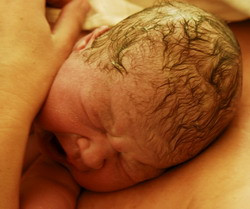The first results from the HRC funded BOOST-NZ study (Benefits of Oxygen Saturation Targeting) are in and they suggest that switching from lower to higher oxygen levels could help more extremely premature babies survive.
BOOST-NZ study lead researcher Professor Brian Darlow from the University of Otago, Christchurch, and his team carried out a randomised controlled trial to test what the optimum oxygen saturation target range should be for very preterm babies. They enrolled 340 babies born before 28 weeks’ gestation in the study from Auckland, Middlemore, Wellington, Christchurch and Dunedin.
The trial is one of a family of five major trials in the US, Australia, New Zealand, Canada and the UK investigating the effects of oxygen saturation levels on the survival and neurodevelopment of premature babies. For this analysis, the New Zealand trial data were pooled together with data from the UK and Australian trials (for a combined total of 2448 babies) and published in The New England Journal of Medicine in May this year. The New Zealand, UK and Australian combined trials are known as the BOOST II trials.
Oxygen is the commonest treatment given to premature babies. However, the clinically appropriate target range for oxygen saturation levels in premature babies is unknown.
“Before this study, most doctors in New Zealand and around the world would target oxygen saturation somewhere in the range of 85 to 95 per cent,” says Professor Darlow. “The aim of this study was to find out if it was better to target the lower (85–89 per cent) or upper half (90–95 per cent) of this range, and whether this affects the number of babies who survive without significant disability by the time they are two years old.”
During the UK and Australian trials, the monitors used to measure the babies’ oxygen saturation had their software updated to make them more similar to other monitor brands used in neonatal units. The New Zealand study continued with the original monitors as the trial had almost finished. Results for the BOOST II studies were reported for all 2448 babies and also for the 1187 babies cared for with the updated monitors.
When the results of all 2448 babies were analysed, no difference was found between the two oxygen target groups in terms of survival. Babies assigned the lower oxygen target of 85–89 per cent did have lower rates of severe retinopathy of prematurity – an eye disease where the retina does not fully develop – than those babies in the higher oxygen target group, but higher rates of a major gut problem called necrotising enterocolitis, leading to surgery or death.
However, when the results for the 1187 babies cared for with the updated monitors were analysed, the researchers found that the babies in the lower oxygen target group were significantly less likely to survive than those in the higher oxygen target group.
Professor Darlow says that the mechanism for the increased deaths seen in the lower oxygen target group is unclear and will need to be the subject of further research.
“Before this study we knew that both too much and too little oxygen could be harmful for premature babies, but we didn’t know what the optimal target range was. This study has helped us to answer that problem. We now know that the baby’s chances of survival will be improved if we don’t target the lower half of the range that was recommended before,” says Professor Darlow.
Together with researchers from the Clinical Trials Centre in Sydney, Australia, Professor Darlow is now analysing the data to find out how well the babies in the study have done at two years of age using the Bayley Scales of Infant Development. These results are expected to be published by the end of this year, and will then be combined with the four other similar studies in a prospective individual patient data meta-analysis to provide even more comprehensive information.
“It’s been a big international collaboration and it’s great that New Zealand could be involved. For the very first time there is some real science behind what oxygen saturation targets we should be using in these very vulnerable babies. I’m confident that this project is going to change clinical practice worldwide.”
